- Home
- slideshows
- miscellaneous
- I visited outlandishly wealthy Dubai, known as the 'city of gold,' and was surprised by how much fun you can have even without billions
I visited outlandishly wealthy Dubai, known as the 'city of gold,' and was surprised by how much fun you can have even without billions
Our trip to Dubai began with $1,145 ticket on Dubai-owned Emirates Airlines. I'd always wanted to fly Emirates, the world's fourth-best airline, and was willing to splurge. While there were options as cheap as $400 with a layover, Emirates turned out to be worth the extra dough. It was the best economy experience I've ever had.

When I got off the plane, I noticed that you can pick up the metro directly from the airport. Depending on where you are going it's between 4 and 8.50 Dirhams ($1.09-$2.31).
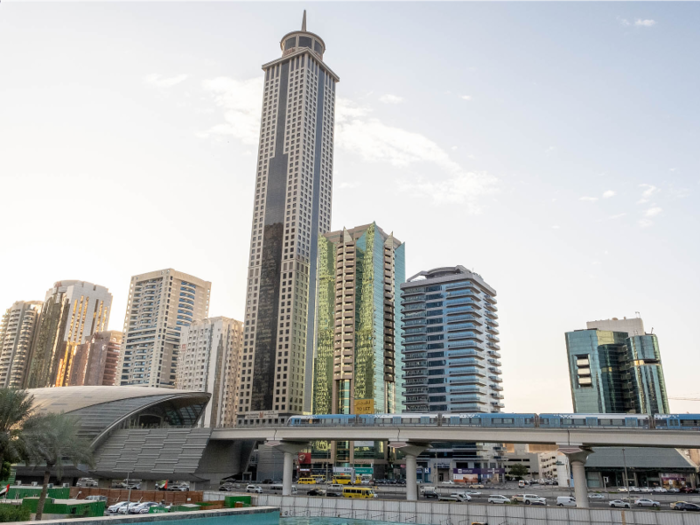
But with the bags, we decided to take a car with Careem, a ride-hailing app founded in Dubai and popular all over the Middle East. Prices are very reasonable. It cost 50 Dirhams, or about $14, for the ride to the hotel.
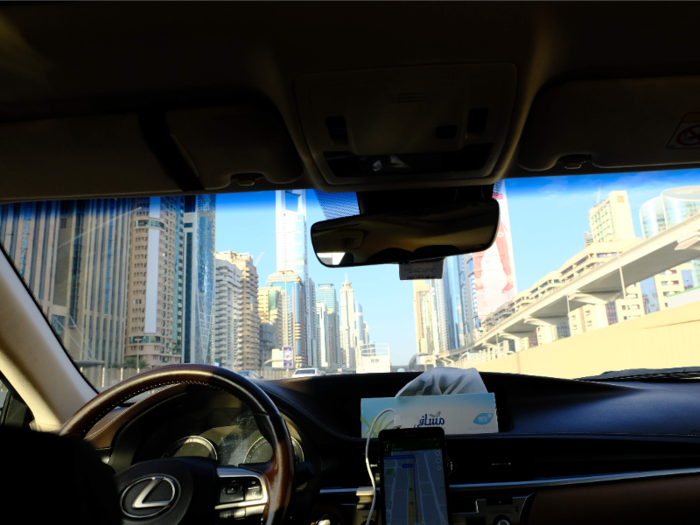
We booked the first few nights at Form Hotel, a chic, design-centric four-star hotel that opened in May. The immediate area, like much of Dubai, was heavily under construction. But the hotel was beautiful and it was next to the metro and a short 10-minute taxi ride from downtown.
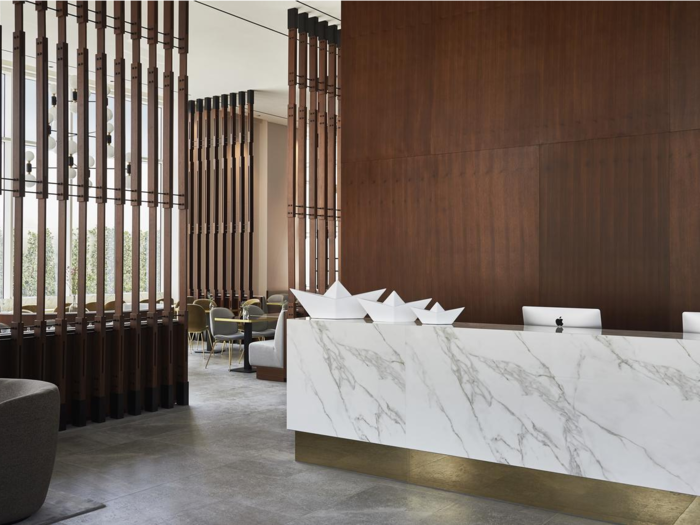
And, at $88 a night, it was a steal. Due to an oversupply of high-end hotels, there are tons of deals to be had in the city. Form was beautifully and efficiently designed.
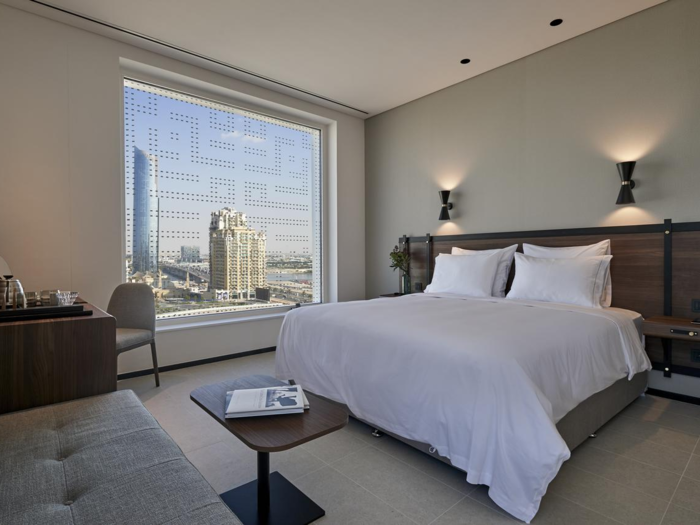
Form's in-house restaurant specializes in healthy, Middle Eastern-inspired dishes with local ingredients. Prices weren't cheap, but there was a great business-lunch deal that included an appetizer, main, and drink for around $25. I ordered the roots mezzeh (beetroot hummus, muhammara, and vegetable tartar) and the roasted Cornish hen. Both were excellent.
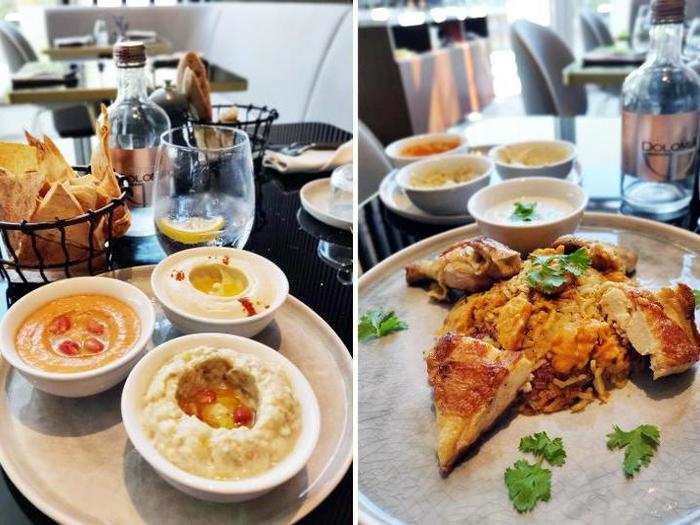
Though there wasn't much around my hotel, it was easy enough to hop on the metro a few stops to get to any of Dubai's more interesting areas or landmarks.
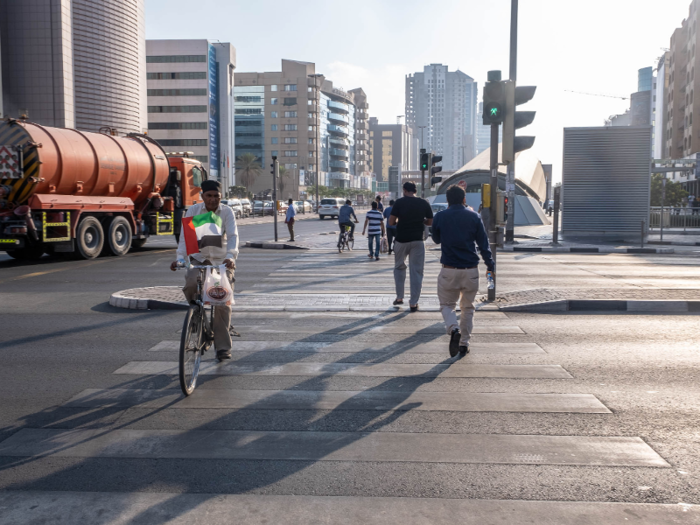
All of Dubai's 49-station, 46-mile metro is completely automated and driverless, making it the third-largest such system in the world. The city's Red Line runs like an artery through the heart of Dubai, making it a super easy and efficient way to get around.
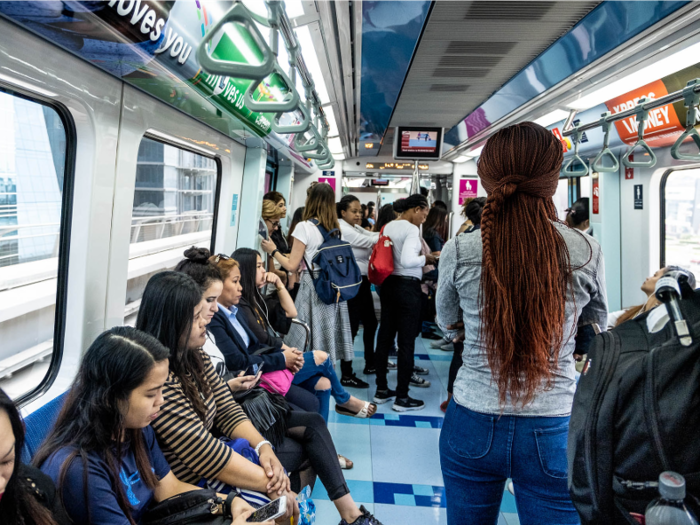
I took the metro straight to downtown. While most of Dubai isn't designed to be pedestrian-friendly (blame the brutal summer heat), a walk through downtown is worth the effort.
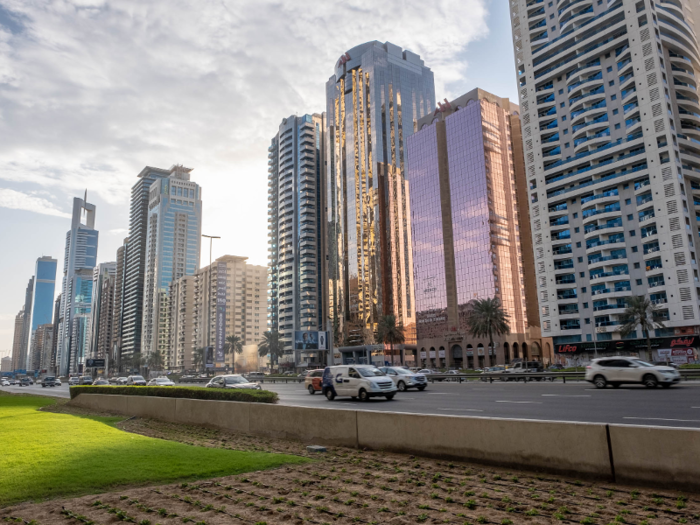
Dubai has the third-most skyscrapers in the world, surpassed only by New York and Hong Kong. The vast majority of the buildings were constructed in the last 20 years and are built as if the world's top architects were given blank checks and complete artistic license to experiment.
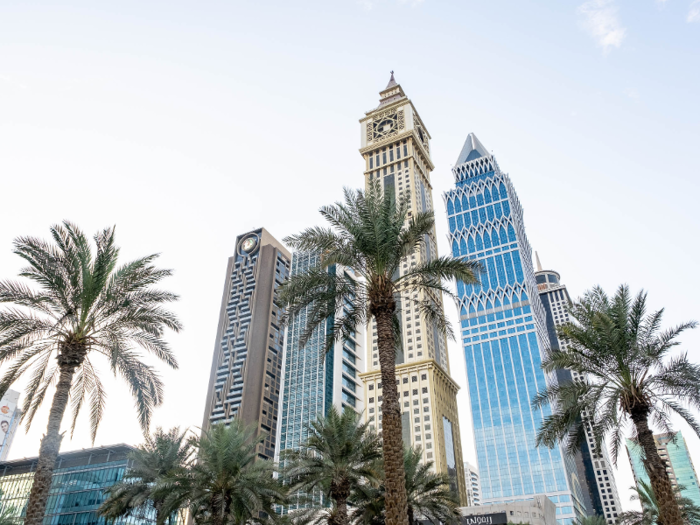
If you were to read most travel guides (or listen to Dubai's tourism board), you'd think that the only attractions the city offers are beaches and hotels on the Palm Jumeirah, the world's largest artificial island.

Or shopping malls. Dubai has 65 extravagant malls that are more like indoor cities. The biggest is the Dubai Mall, a gargantuan complex with 1,200 stores, an aquarium, a virtual-reality theme park, an Olympic-size ice-skating rink, and hundreds of restaurants.
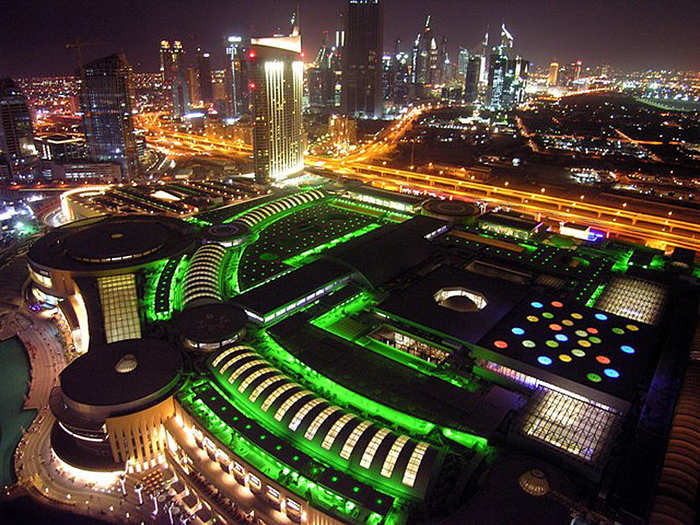
I visited one evening, but, to be honest, it's just a mall. For travelers who don't get access to American brands or high-end boutiques or those that love to shop, it's worth a visit. The rest can skip.

But I found the true heart of Dubai's culture to be its immigrant communities, which make up nearly 94% of the city's population of the city's 3.2 million people.
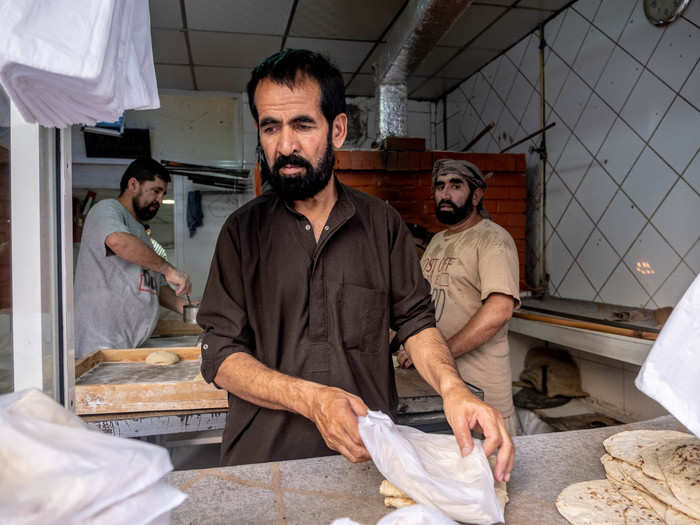
Source: Visit Dubai, Dubai Statistics Center
The biggest group, by far, is Indians, who make up close to half of Dubai's immigrants. That makes it very easy to get delicious, cheap, and authentic Indian food. For dinner one night, I went to Fish Hut, a restaurant known for grilling and frying fresh seafood in Indian spices. I got the spicy Calabari curry with a whole fish for 22 dirhams, or $6.
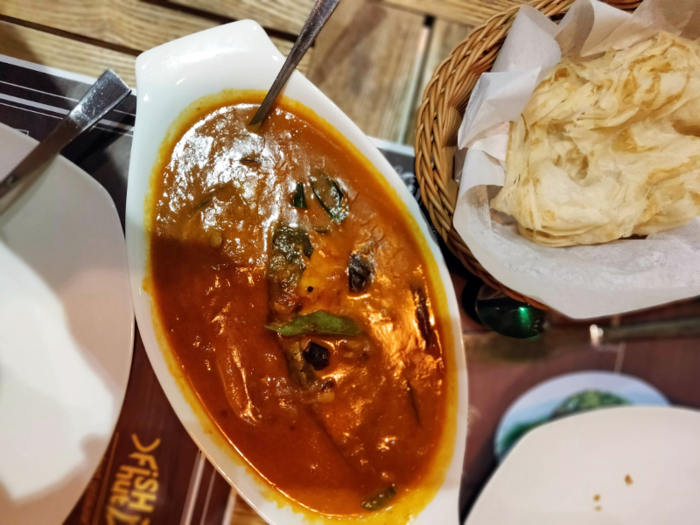
Source: Dubai Statistics Center, Fish Hut
Indians are far from the only immigrants. There are sizable populations from Pakistan, Bangladesh, the Philippines, Egypt, and even Afghanistan. The following day I ate at Khorasan Kabab, an Afghani restaurant with traditional dishes like Kabuli palaw and grilled lamb. Dishes were around $6 to $8 and came with a variety of sides.
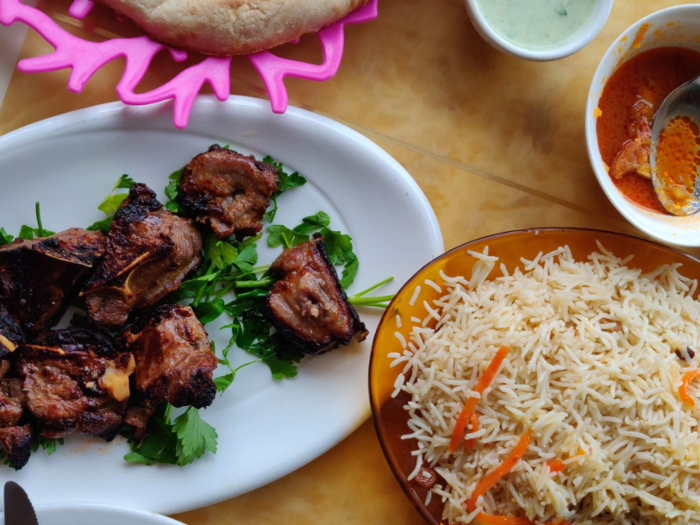
After a couple of days, I felt like I had figured out how to do Dubai cheaply, but I didn't feel much closer to the culture. Then I met Nada Badran, a Jordanian who has lived in Dubai for most of her life and who hosts "Wander With Nada" on CNN Arabic.
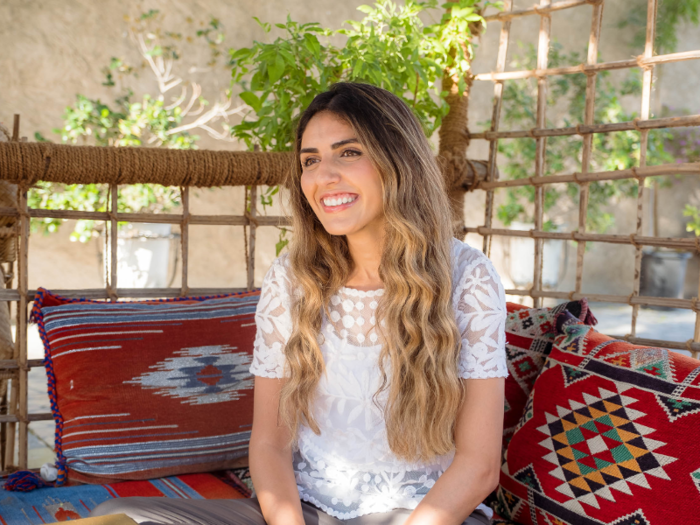
"A lot of people visit and say that Dubai has 'no soul' but that’s so far from the truth," Badran told me. "You just have to put in the effort to look for the culture." To get a window into the real Dubai lurking behind the city's shiny new landmarks, Badran took us to the Gold Souk in Deira, one of the city's oldest neighborhoods.
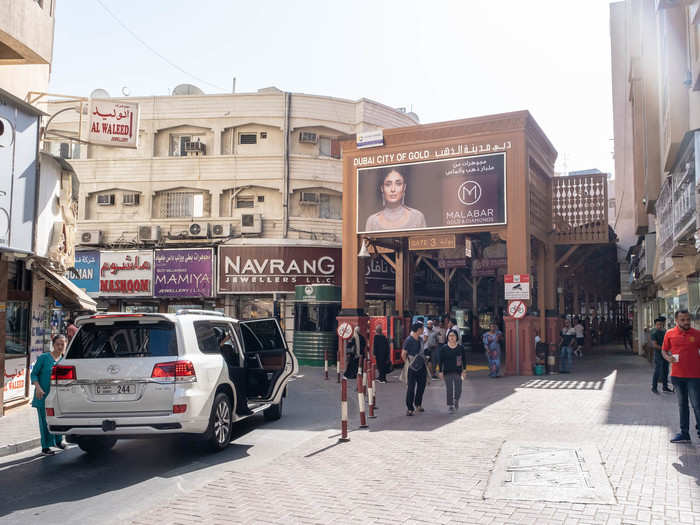
Dubai is often called the "city of gold" due to its meteoric rise to wealth in a single generation, but the city could be called that for another reason: As of 2014, 40% and $75 billion of the global gold trade flowed through Dubai. Much of it goes through the Gold Souk, the largest of the city's jewelry markets.
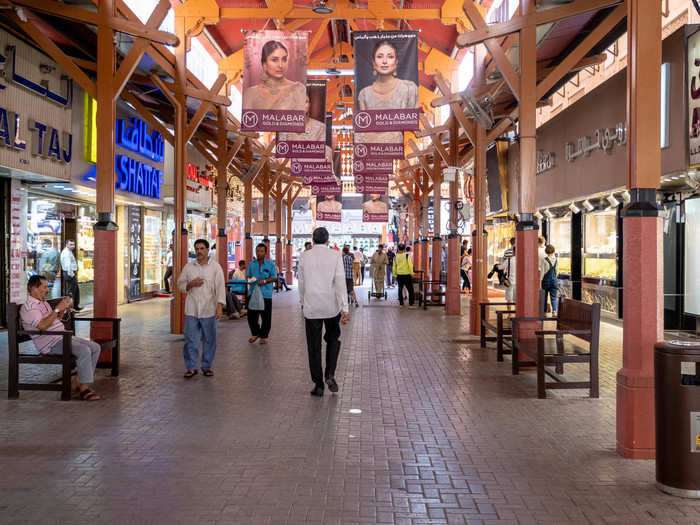
Source: Kitco
The price of gold in the market is determined by three factors: the weight or karat of the gold, the design, and the labor needed to make the piece, explained Badran. While the karat and weight prices are government-regulated, everything else is negotiable.
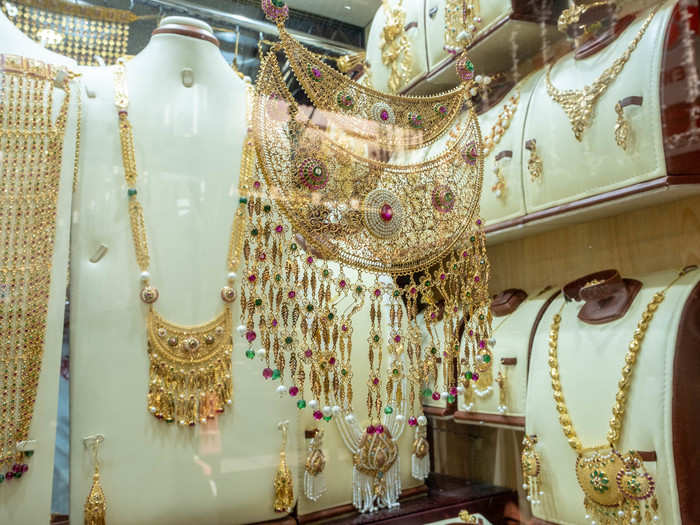
The primary customers in the Gold Souk are Indians, Chinese, and Emiratis, Badran said. Purchasing gold in Dubai is so popular because labor is cheaper and, up until last year, there were no taxes. The Dubai economy has been so hard-hit by the newly introduced value-added tax that it is considering doing away with it for tourists.
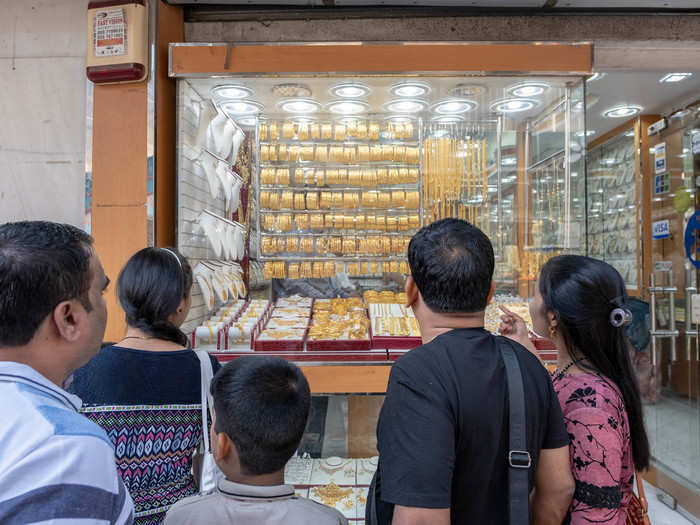
Source: Kitco
You can see the influence of the customer base on the style of the elaborate jewelry on display. These pieces cater to Indian customers, Badran said.
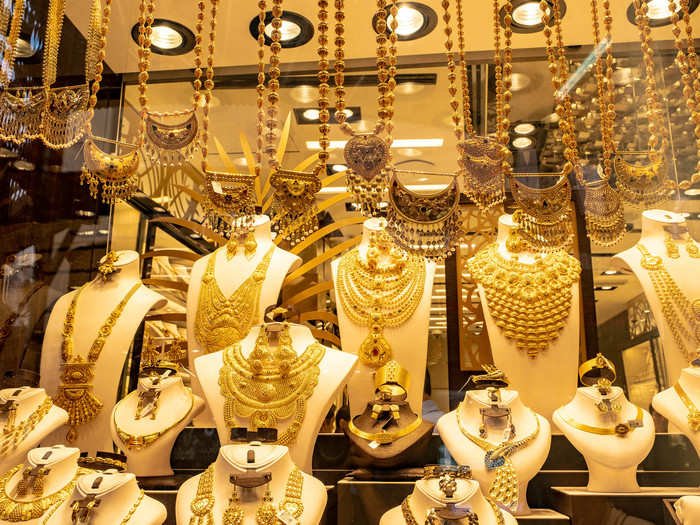
"It is tradition to buy gold in some cultures, for special occasions such as weddings and births, and they don't stop buying because of price changes," Bhavin Sagar, the owner of Shantilal, a family-run business over 50 years old, told The National.
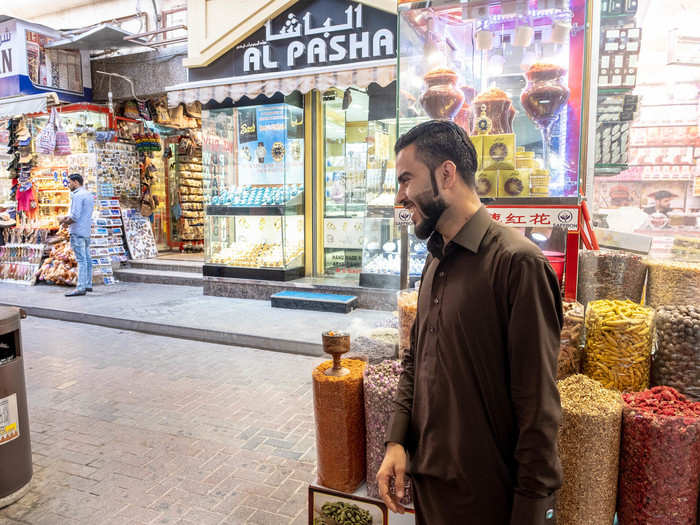
Source: The National
For Indian, Chinese, and Emiratis, gold often functions as part of a dower or "bride price," by which the husband and his family pay the bride and her family for the marriage. The wedding pieces, like this one, can get incredibly elaborate and cost in the tens and hundreds of thousands of dollars.

Dubai's Gold Souk has the world's largest gold ring on display. The 21-karat Najmat Taiba weighs 141 pounds and costs approximately $3 million. There's a lot of people trying to get a selfie there.
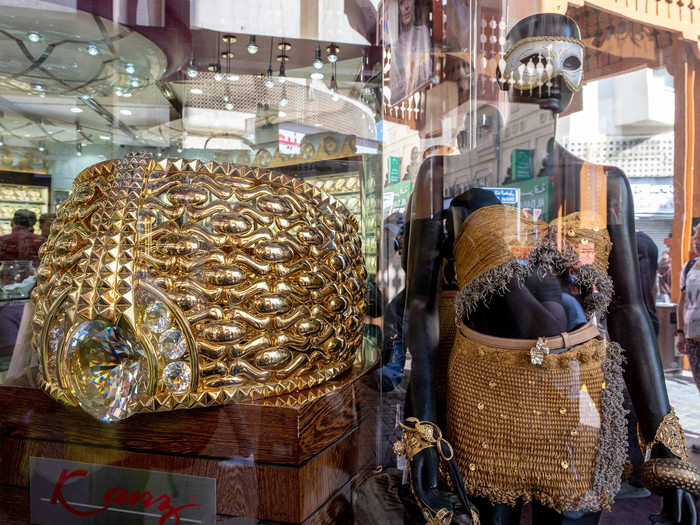
Source: Business Insider
The Gold Souk is far from the only market. Dubai has a long reputation as a commercial and trading port dating back to the 1800s. Deira's souks are where the "story of Dubai started," Dr. Hasan Al Naboodah, an Emirati historian, told The National.
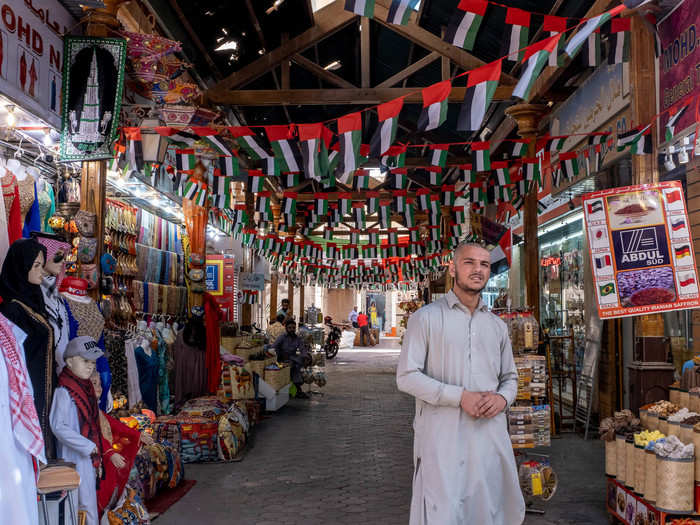
Source: The National
A few minutes from the Gold Souk is the Spice Souk. It's full of tiny alleyways full of tiny shops stocked with every kind of scent imaginable. It's a kind of sensory overload. Like many of Deira's souks, it's a place for locals to buy everything from saffron and turmeric to sulfur powder (the yellow rods on the left) and natural indigo (the blue balls).
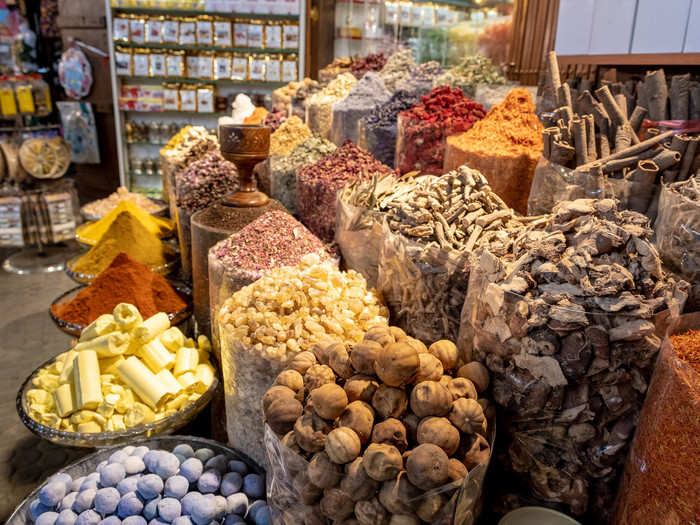
Badran had us stop in on a spice shop to get an education in the spice trade. As Badran explained, most shops in the spice souk are run by Iranian immigrants and most spices come from Iran.
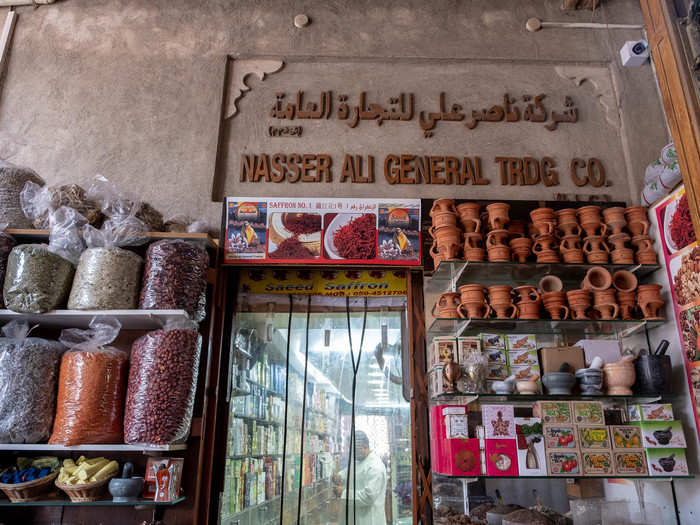
Badran introduced us to Saeed Neamatpour, an Iranian immigrant whose uncle owns the Nasser Ali spice shop. He provided us with a look at some of the shop's biggest sellers, including dates (of which there are more than 120 varieties) and oudh, a smoky resinous wood used by Emiratis as a kind of perfume or cologne.
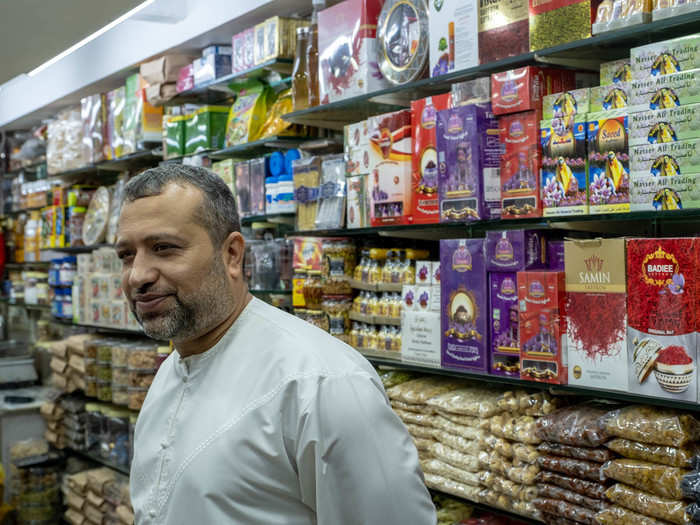
Iran is particularly famous for saffron, the most expensive spice in the world and one often called "red gold." The best stuff can sell for as much as $20 a gram. Iran produces a whopping 85% of the world's saffron.
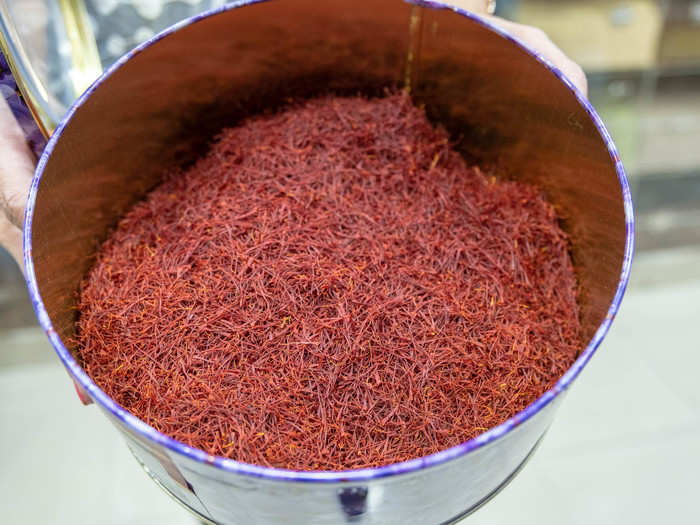
Source: National Geographic
The second most expensive spice is vanilla, which comes from orchids that are exceptionally difficult to pollinate. These ones, from Madagascar, smelled as intoxicating as you can imagine.
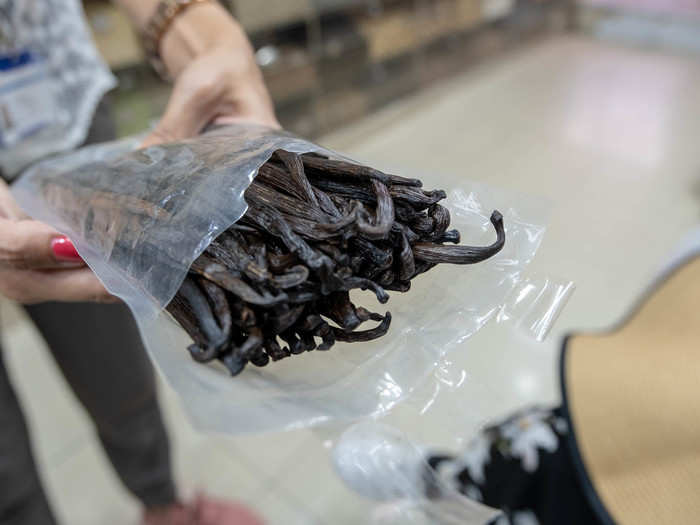
The Spice Souk is a pretty good place to try faloodeh, a traditional Iranian dessert of vermicelli noodles with ice and rose-flavored syrup.
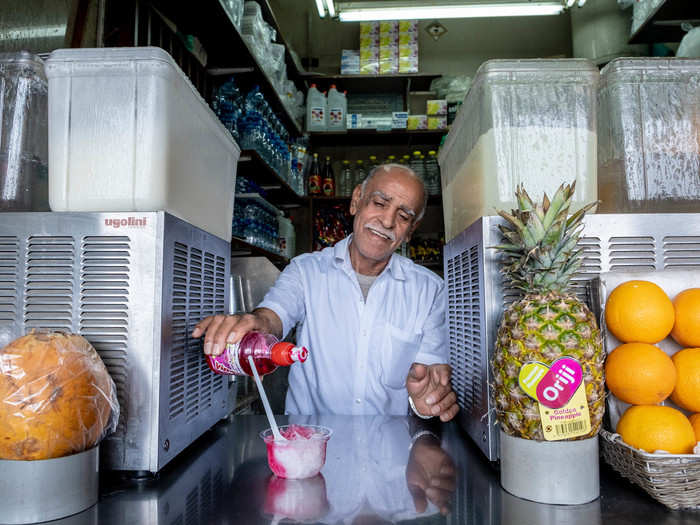
In order to get to Dubai's oldest neighborhood, Bastakiya (now known as al-Fahidi), we had to cross the Dubai Creek. The best, and most scenic way, is on an abra, a traditional Emirati water taxi. It costs 2 Dirhams for the ride.
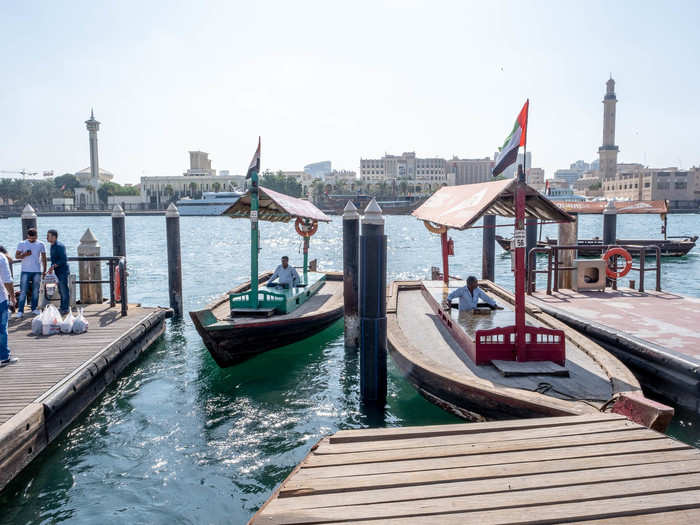
Riding an abra with the wind at your back is one of the most beautiful ways to see Dubai. You can ride all the way to downtown Dubai, but we were only heading across the water to Dubai's oldest souk, the Textile Souk.
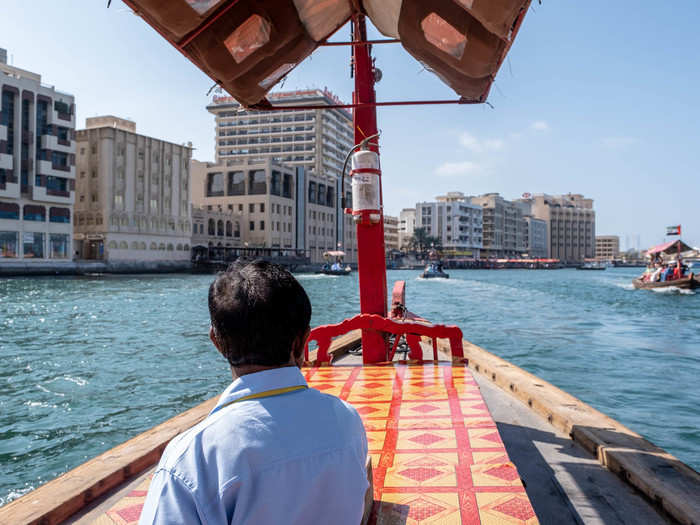
The textile souk is also known as the Old Souk. It is a bit more touristy than the other markets, no doubt due to the fact that its goods (fabrics, souvenirs, and clothes) are the things tourists are most likely to buy.
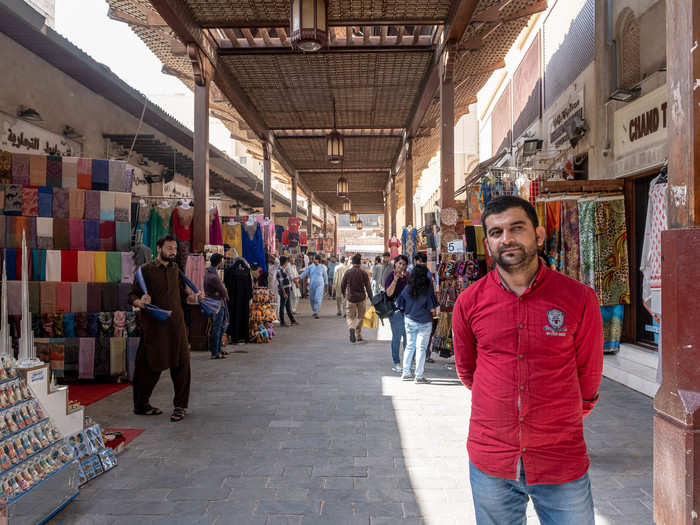
Badran introduced us to Abdul Rawof Khan, a textile seller originally from Afghanistan, for an education in traditional Arabian clothing.
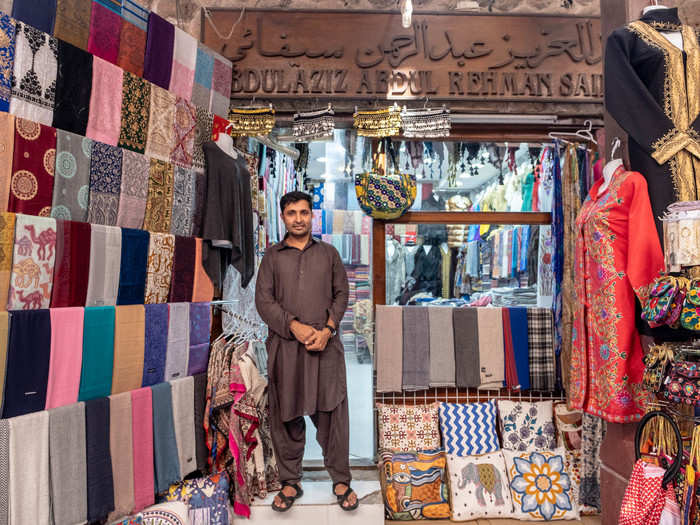
As Badran explained, there are slight differences in the headscarf, or keffiah, and white robe, or kandora, that those from the Arabian Gulf wear.
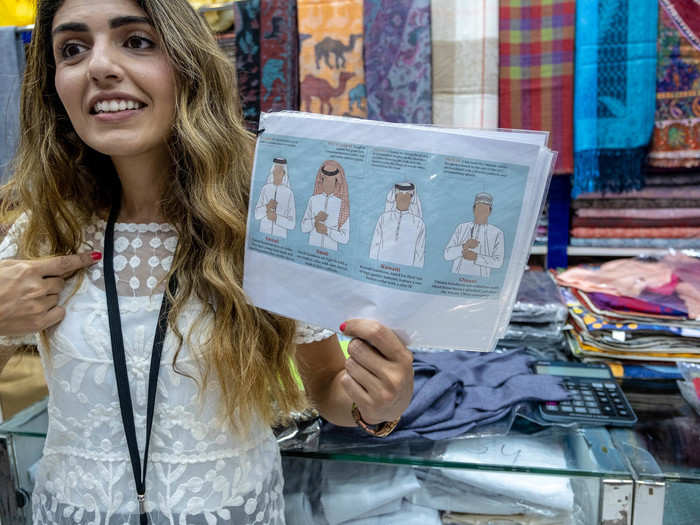
Khan convinced me that I had to try on the traditional Emirati keffiah and kandora. The Emirati kandora is collarless and features a long tassel known as a tarboosh.
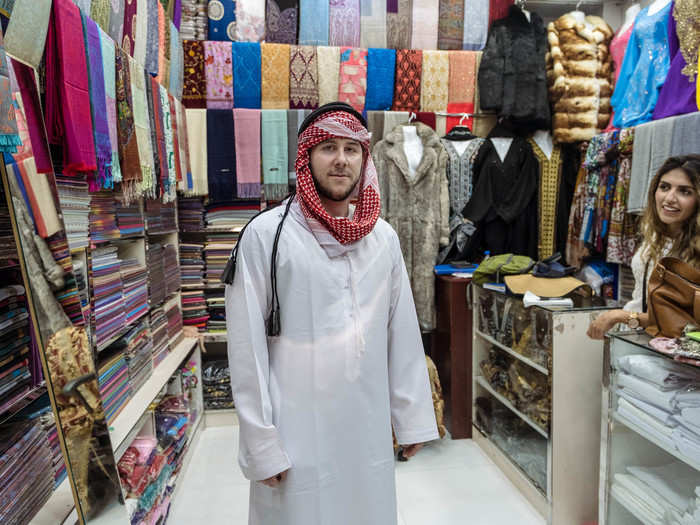
Annie, meanwhile, tried on a traditional Emirati abaya. In contrast to the more plain black abaya and niqab worn in some other Arabic countries, the Emirati abaya is often decorated with sequins, patterns, ribbons, and embroidery.
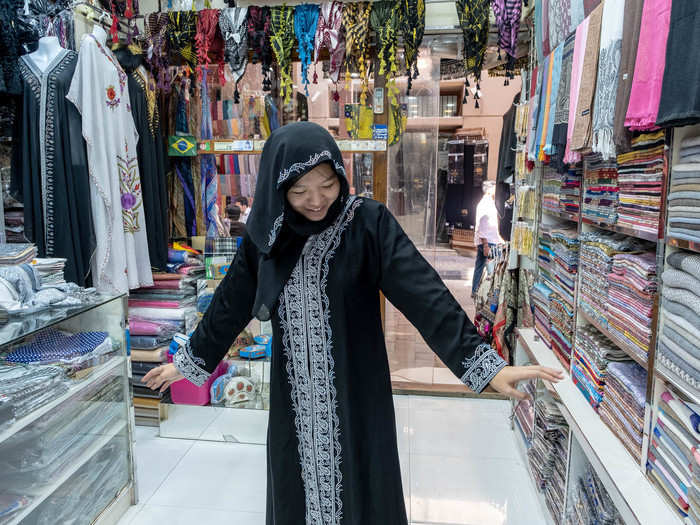
Source: Istizada
A short way from the textile souk is one of Dubai's two Hindu temples. The temple has long been one of the only places for Dubai's approximately 500,000 Hindu-practicing Indian immigrants to worship.
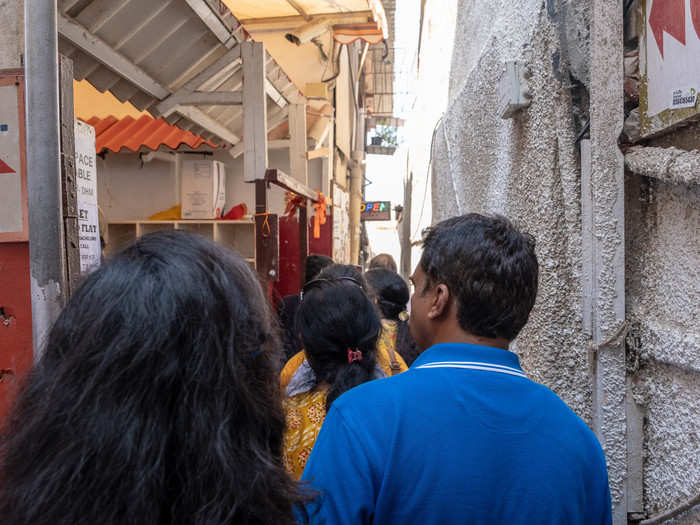
It gets crowded on the big holidays. It's not very big, as you can see from the alleyway you take to get there and the ceremonial washing station in front.
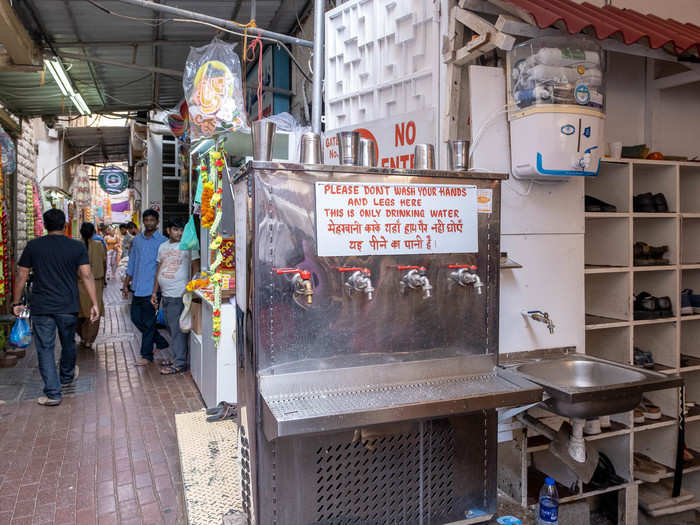
The alley to the temple is packed with small shops selling exactly the same thing: fruit and flower offerings to the gods.
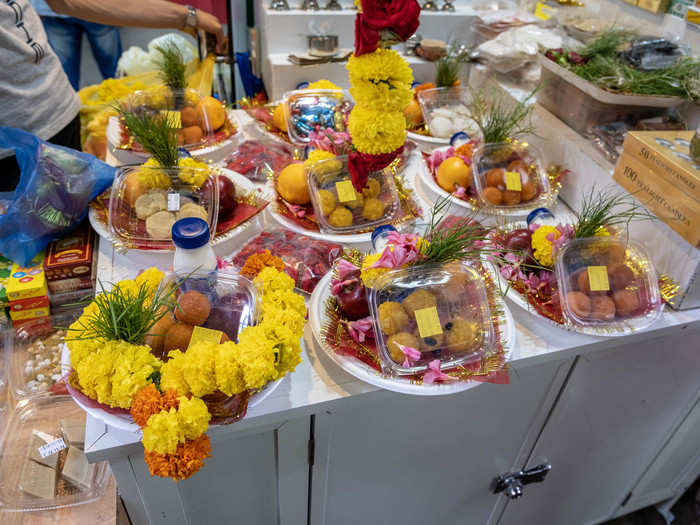
There's a few selling more varied Hindu-related paraphernalia.
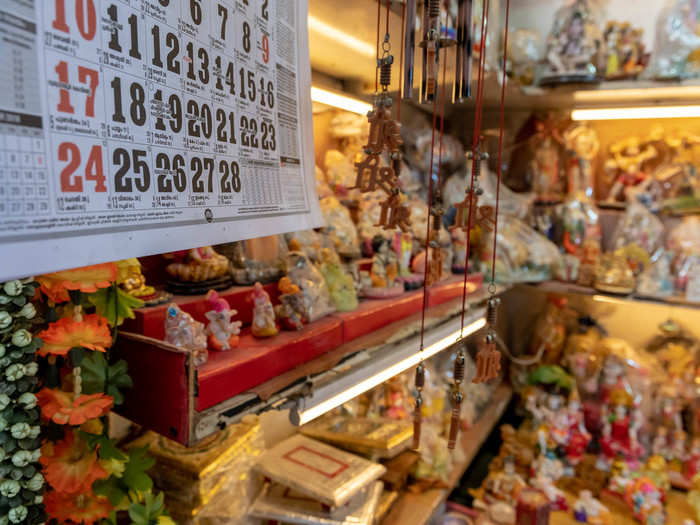
Once wandering out of the alleyways, we found our way to Dubai Museum. While I didn't get a chance to go inside, the building itself is impressive enough. It's known as Al Fahidi Fort and was constructed in 1787. It's the oldest building in Dubai.
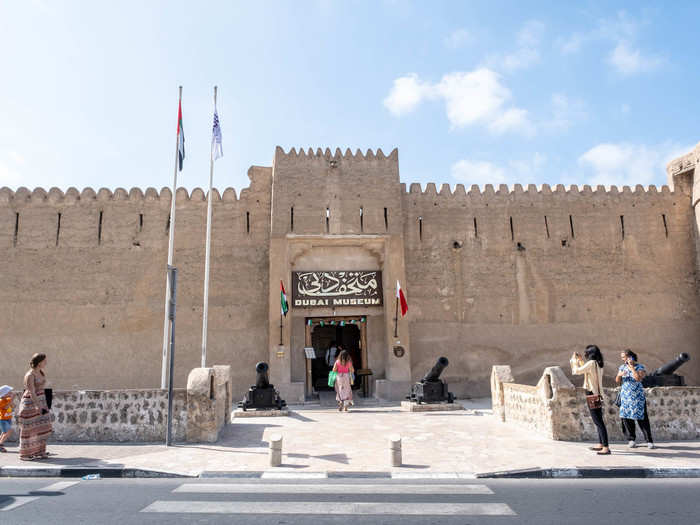
Instead, we carried on to Bastakiya, the city's oldest neighborhood and one whose traditional Arabian-style architecture is still intact. The Arabian Tea House has become a popular haunt for locals, tourists, and even visiting celebrities. Opened in 1997 by lifelong Dubai resident (and restless traveler) Ali Al Rais, the restaurant is housed in a house built in the 1920s.

Source: Friday Magazine
Like many Arabian buildings of the time, it has a wind tower, or malqaf, that funnels wind into the building for natural air circulation and cooling. It's an ingenious bit of ancient Persian architecture.
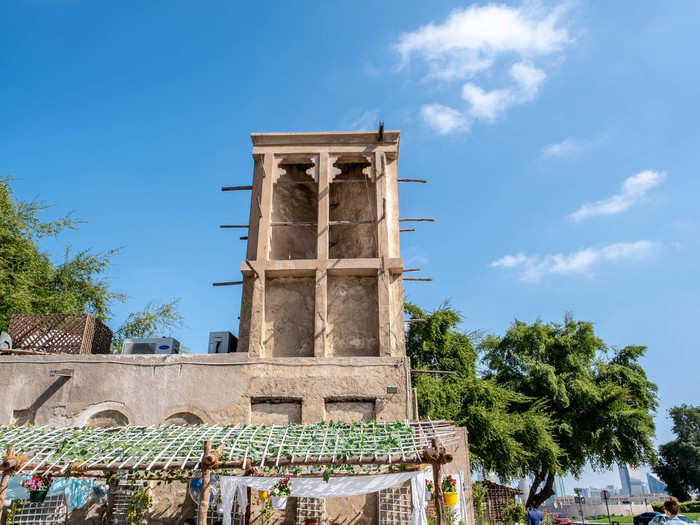
The labyrinthine alleyways of Bastakiya harken back to when the nation's Bedouins were primarily herders, pearl divers, fishermen, and date farmers.
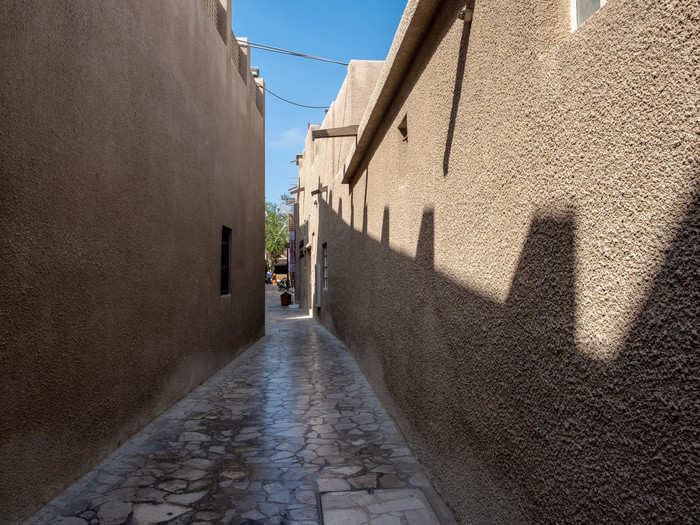
Bastakiya was founded in the 1800s by merchants from the Persian town of Bastak. At the time Dubai was a major stopping point along global trade routes through the Middle East and Asia. Legend has it that the sheikh who ruled the area provided generous tax breaks to the merchants who built mansions in the area.
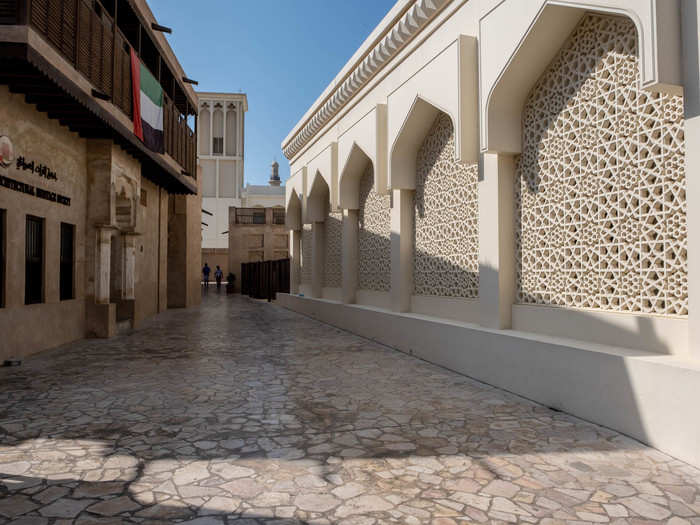
Source: Forbes India
There's a small exhibit dedicated to what traditional Bedouin life in the desert looked like. Before Dubai was Dubai, the native Bedouin population migrated back and forth between the desert and the coast depending on the season.
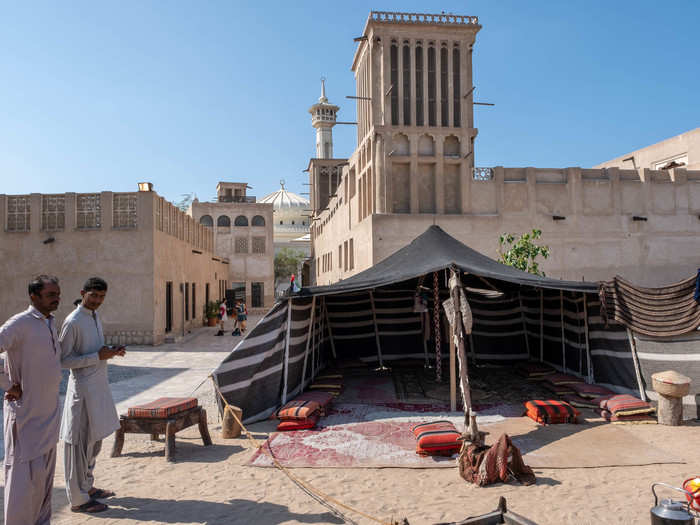
Today, the neighborhood is eerily quiet and exists almost entirely as an open-air museum to long-past Emirati culture. Still, it's a visual treat to spend some time in …
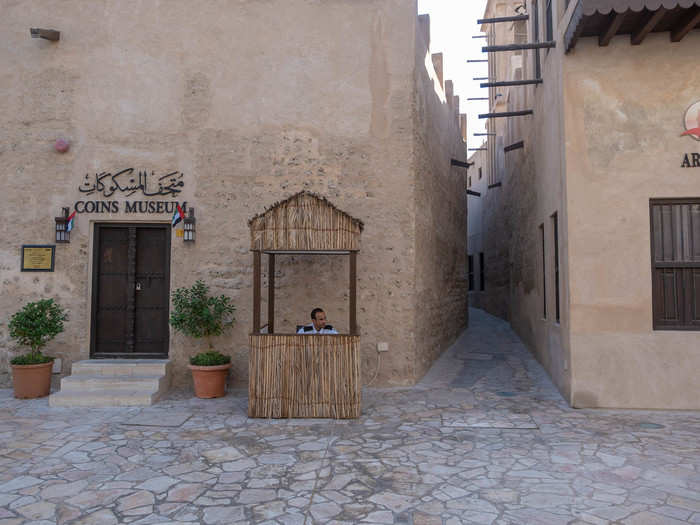
... And maybe even find some traditional handicrafts as souvenirs.
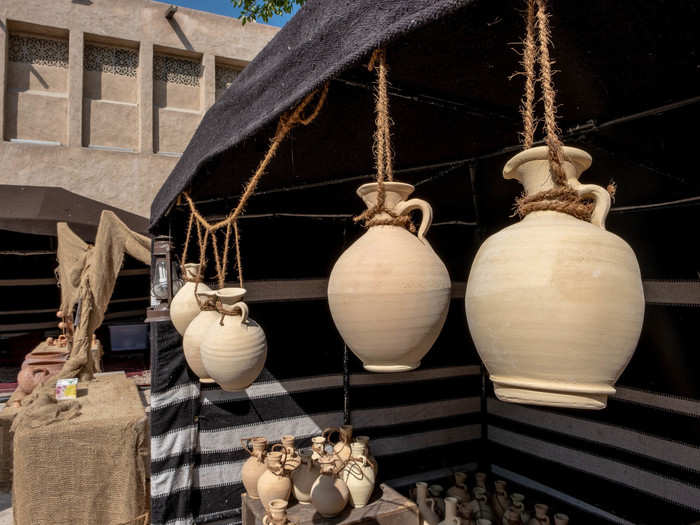
The alleyways are lined with ochre-colored buildings. Most are made of a combination of coral, mud, gypsum, or palm wood and now serve as hotels, cafes, or art galleries.

Some art galleries to check out include XVA Gallery and Majilis Gallery, which both specialize in contemporary Arab art.
The liveliest part of the district is at the Al Serkal Cultural Foundation. Set in a traditional house built in 1925, it features a cafe in the center courtyard with small art galleries and boutiques in the surrounding rooms. It's a calm oasis in which to while away a day.
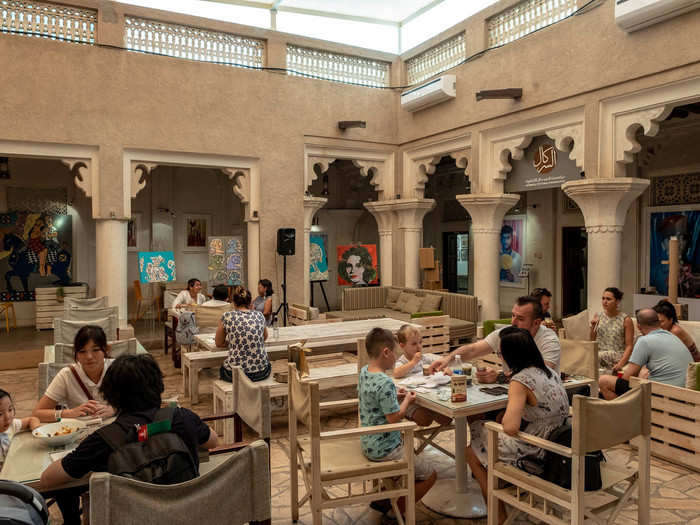
One of my favorite artists was Jordanian couple Maysoon Masalha and Bassam Al Selawi, who create "shadow art" sculptures. The wooden sculptures depict one thing, while the shadow often depicts something entirely different. This sculpture of two horses kissing shows a man and a woman in the shadow.
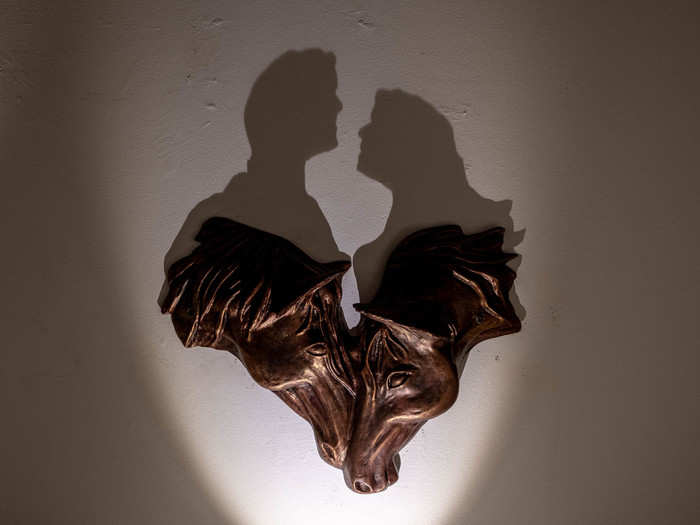
There are hidden gems like the gallery of Mike Arnold, Philadelphia-born architect who became a painter full-time in 2013. "I've got my gallery here because every single person that wants to learn something about the real Dubai turns the corner there," he told us, as he pointed outside his studio door. It was true — we had just turned that corner when we stumbled in.
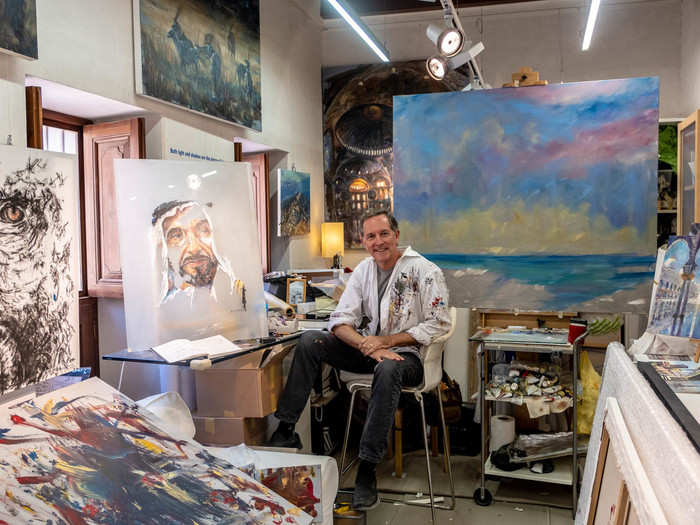
Afterwards Badran took us to Al Ustadi Special Kebab for some traditional Middle Eastern grub. Run by four brothers and started by their father, Mohammad Ali Ansari, the Iranian restaurant has been around since 1978 and is a favorite for many Dubai residents.
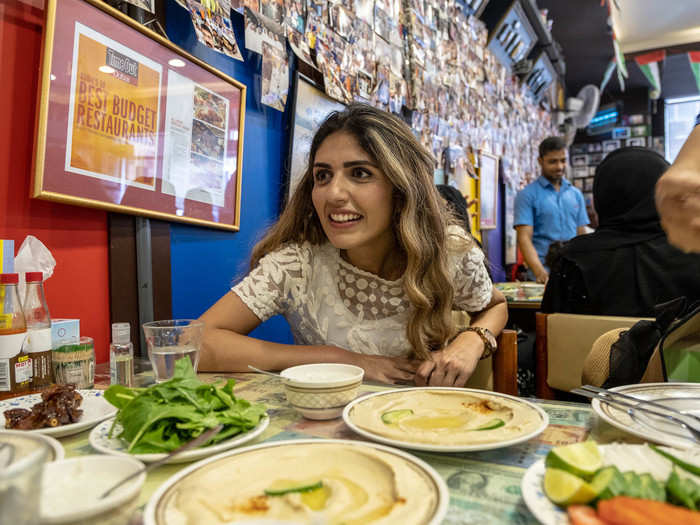
Badran ordered us a platter of salads, hummus, and "special" kebabs. While Ustadi has a number of different kebab types, it's the kebab khas, or special kebab, that keep Dubai residents coming back. The kebabs come with chicken or goat and are marinated in a top-secret recipe of spices and soured yogurt, which has a tangy flavor you don't forget.

Za’atar and sumac, two spice mixes popular in many Middle Eastern cuisines, are always on the table. While Zaatar has a pungent nutty flavor, sumac adds an almost citrus zest to food. With Badran's direction, we threw them onto everything.
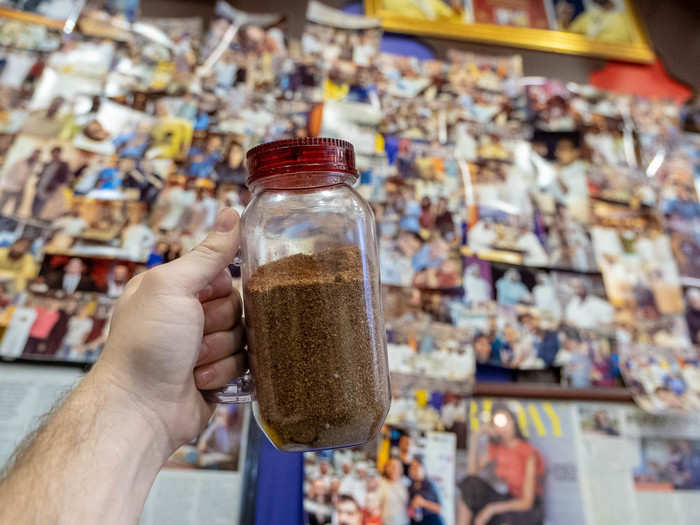
The proper way to eat the kebabs is with a bed of rice layered with yogurt sauce and dates, a nod to the Ansaris' childhood selling dates as a child. For many, like writer Govind Dhar, Ustadi is a vestige of the Old Dubai, when immigrants from Iran, Pakistan, India, and elsewhere first moved to the city and found commonalities in tea and good food.
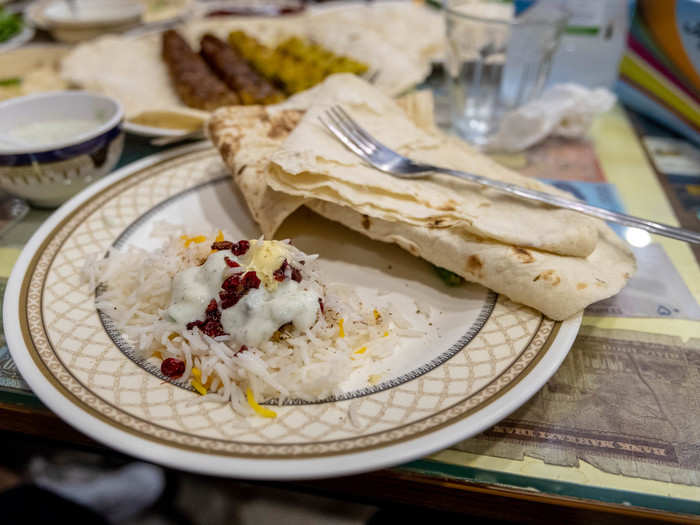
Source: Roads & Kingdoms
The following day, I went to have a look at the real center of Dubai's arts scene, the area known as Al Quoz, an industrial area that has recently spawned art galleries, cafes, and music venues.
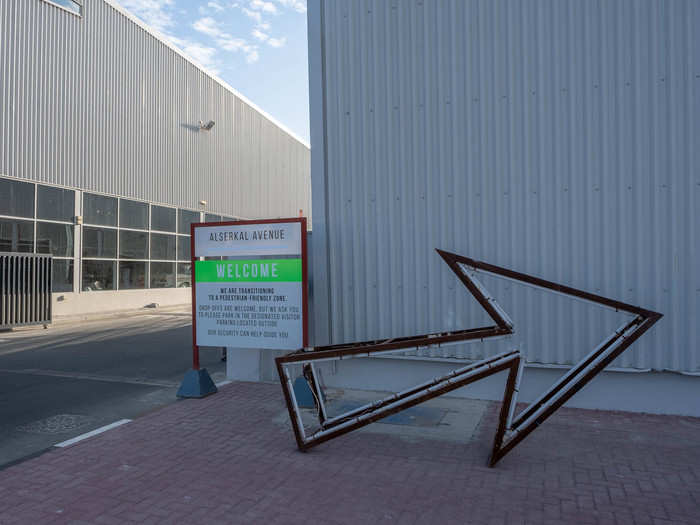
Most of the action is centered around Al Serkal, an arts and culture hub located in a series of warehouses.
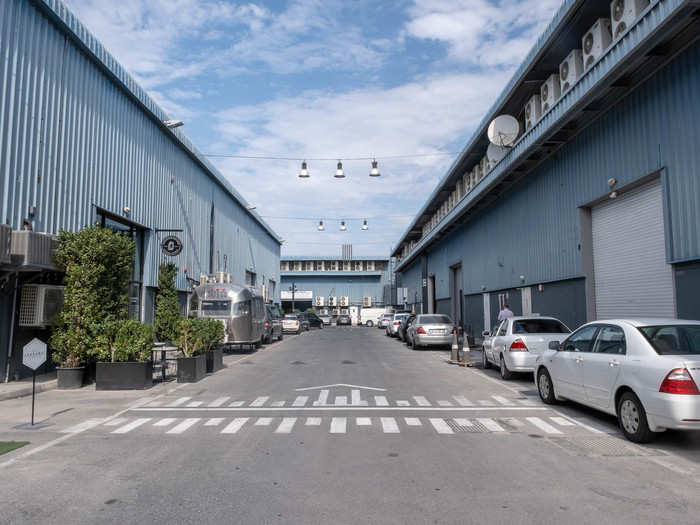
There's a co-working space at the center that doubles as a cafe, a small boutique, and an information center. I stopped for a quick snack.
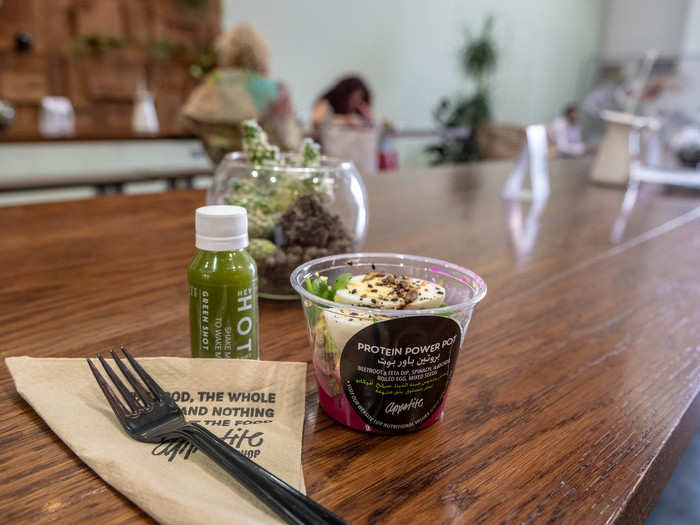
And then I went to hit the art galleries. There's Ayyam Gallery, an arts organization started in 2006 with a mission to expand "the parameters of international art."
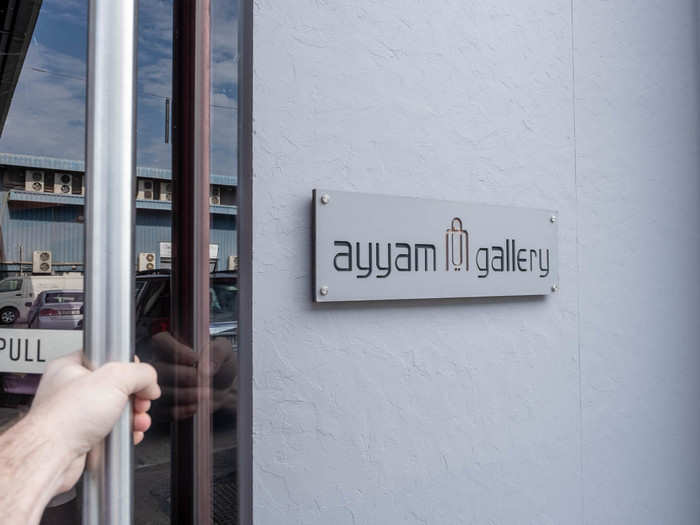
When I visited, Ayyam was featuring the work of Thaier Helal, a Syrian-born artist. The collection was called "Beneath The Rubble" and was an impressionistic set of mixed media works that look like different expressions of rubble in both an emotional and physical sense.
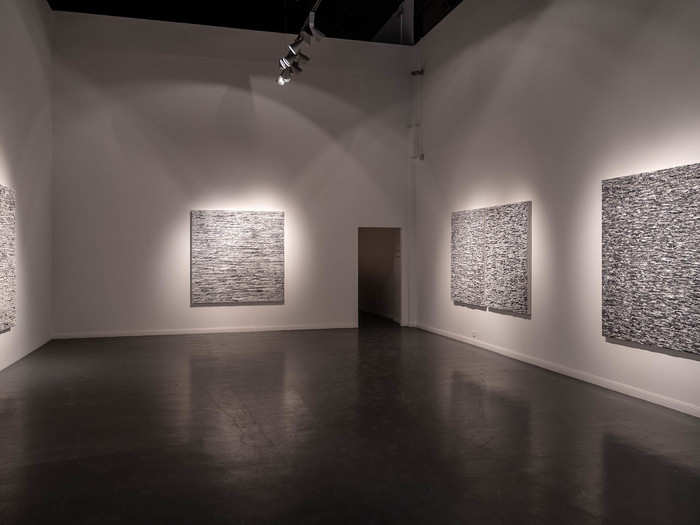
At the 1X1 Gallery, I was introduced to the work of Sunil Gawde, a Mumbai-based artist who makes sometimes-humorous, sometimes-absurd sculptures that bend reality. It's pretty trippy stuff.
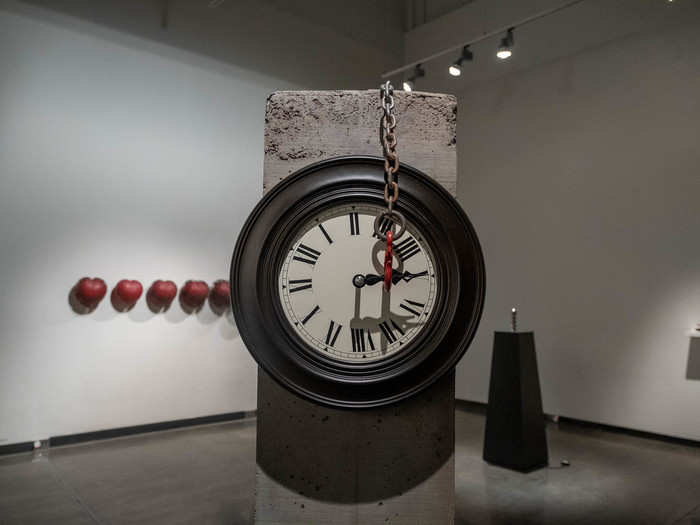
The area also has some hip clothing boutiques, like Somewhere in Between. It was holding a "garage sale" where you could buy just about anything, from leather journals to a Sega Genesis.
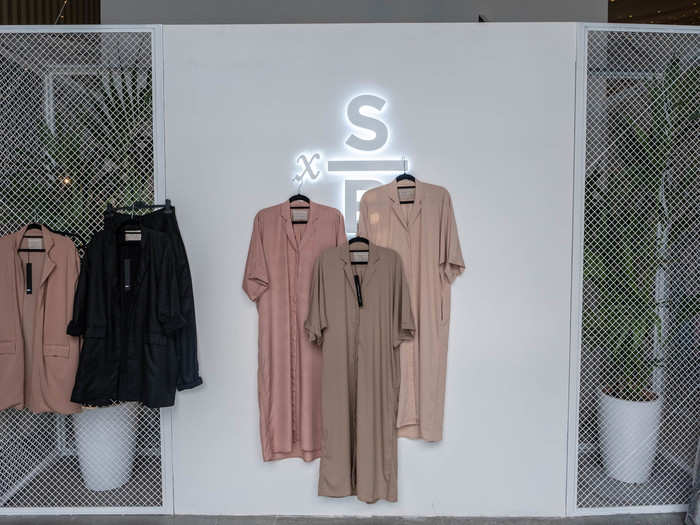
Or some hip clothes catering to a Middle Eastern audience. Which is to say they were fashionable while still being modest. Annie picked up an ankle-length sand-colored maxi skirt for $15. A steal, Annie tells me, when its retail price was $50.

Al Serkal also hosts movie nights, events, talks, dance classes, and workshops. The programming is eclectic — everything from a screening of a documentary about Syrian refugees to a reading group for Ayn Rand's "The Fountainhead."
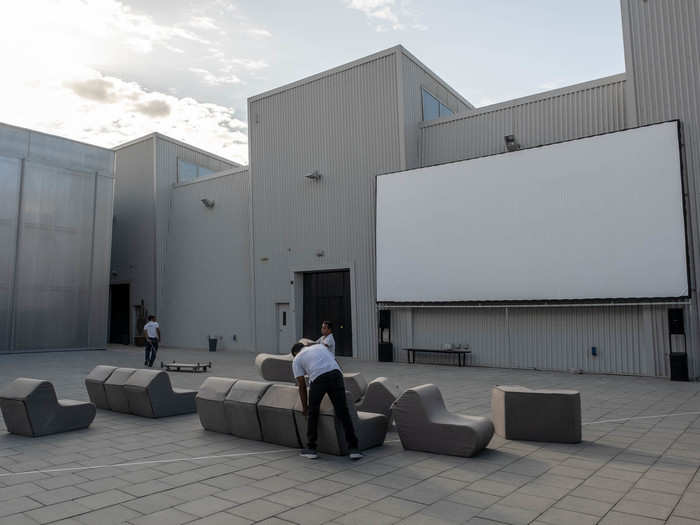
By the end of my time in Dubai, it was clear that we were only just scratching the surface. There's a lot more to the city than the Burj Khalifa. And though we did visit the observatory of the aforementioned world's tallest tower, we found the history and culture lurking underneath the futuristic steel-and-glass facade to be far more interesting.
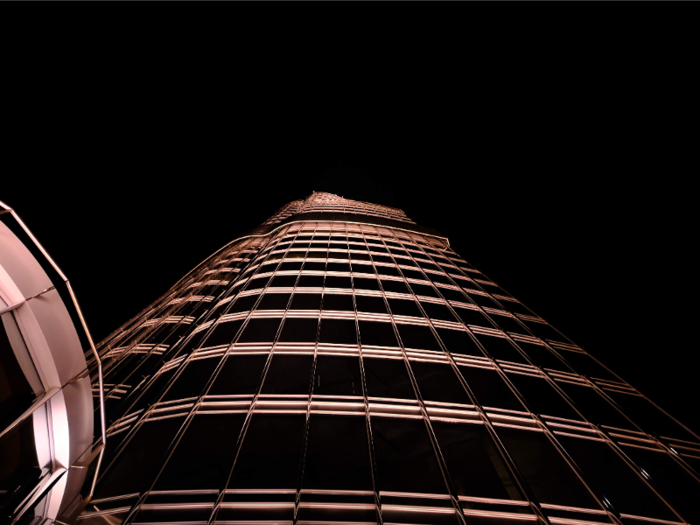
Popular Right Now
Popular Keywords
Advertisement